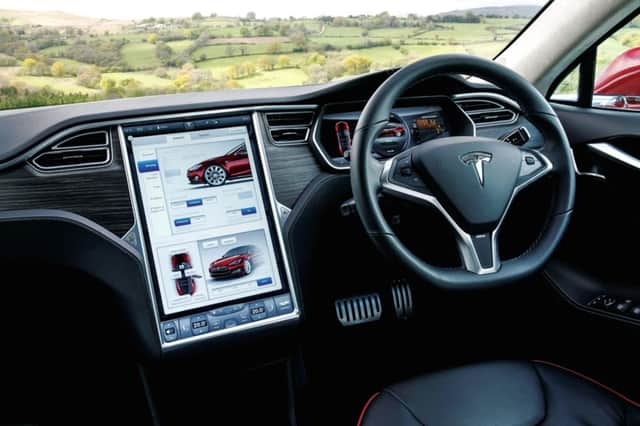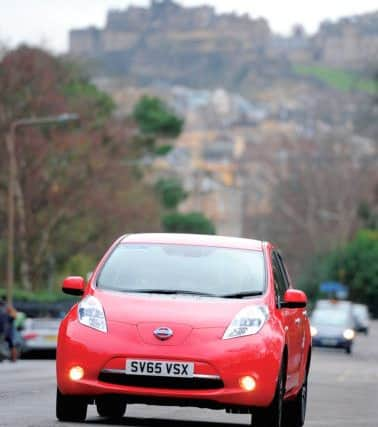Will electric cars catch on in Scotland?


The lone Model S which fills the showroom draws a crowd with people queuing to take a seat behind the wheel while others press tentatively on the door handles before watching with amazement as they pop out from the body of the vehicle – it makes the car more streamlined, the sales adviser tells me.
The bonnet is propped open revealing an empty space where the motor should be but of course Tesla’s Silicon Valley engineers have expertly managed to hide this elsewhere, leaving the front free for extra storage.
Advertisement
Hide AdAdvertisement
Hide AdWith a range of up to 330 miles on a single charge and the ability to reach 0-60 mph in as little as 2.8 seconds, this really is top of the range when it comes to electric cars.


Realistically, most of us probably don’t have a spare £51,900 plus to spend on the Model S, but with Scotland’s charging infrastructure developing year on year, running an electric vehicle (EV) is becoming ever more viable.
Tesla’s aim is to educate the public about EV technology in a familiar retail environment. They may only be gathering momentum now, but electric cars are not new.
Battery powered vehicles have been on the roads since the mid 19th century although it has taken modern technology to transform them into potential competitors for their petrol and diesel fuelled cousins.
Douglas Robertson, chair of Electric Vehicle Association Scotland (EVAS) says that Scotland’s charging network has seen significant growth but there is still work to be done.


East Lothian Council now has eight public charging points (including two rapid chargers) in its area.
Edinburgh City Council has 61 charge points across 24 sites, while West Lothian Council has four. In total, Scotland now boasts 900 publicly available charging bays. But is this enough to make running an electric car a practical option?
“When I bought my first Nissan Leaf in 2013 there were four rapid chargers in Scotland and now there are about 120,” says Robertson, who was converted to electric cars after spending 10 years designing Heathrow’s electric pod system, Ultra.
Advertisement
Hide AdAdvertisement
Hide Ad“The government is committed to increasing the charging infrastructure in Scotland. It’s getting to a stage where you can drive most of the main routes in Scotland.
“Rapid chargers are 50kW units which can charge the car in about 20 to 25 minutes in the summer. In the winter it might take another ten minutes. You would use a rapid charger if you were going from, say, Perth to Aberdeen.
“Then you have another kind of charger called posts. These can either be 7kw or 22kw. The third level is a home charger. In Scotland a home charger is free and you can get a 7kw charger through government funding. If you were in England you would be able to get a 3.3kw charger for free.”
Government grants are available to help people buy a plug-in vehicle as well as to install a home charge point.
According to Robertson, one of the main issues for EV owners is bay blocking. This can be caused by some drivers parking their internal combustion engine cars in EV charging bays or by drivers of EVs and hybrids parking for free in a public charger space and leaving them there all day. “We need to educate people not to do that,” he says.
“One of the ways EVAS is hoping to do that is to develop with Transport Scotland a sensible billing regime for charging for the electricity which is currently free.”
Another suggestion is to introduce multi-unit charging hubs along Scotland’s trunk roads, a system which is already working well in Belgium, Germany and the Netherlands.
As I climb into the passenger seat of Robertson’s red Nissan Leaf, he begins to dispel the common myths about electric cars. “The first myths is that EVs are expensive,” he explains. “They’re not. I keep a spreadsheet of all my costs. I take meter readings every day so I know how much I have used.”
Advertisement
Hide AdAdvertisement
Hide AdAnd sure enough, Robertson’s figures shows the Leaf’s fuel costs total £358 over two years compared to £2,635, the cost of filling up his old Skoda Fabia. The cost per mile comes out at 25p compared to 56p for a diesel car, while the exemption from paying road tax is a another saving.
“The second myth is about the range,” Robertson continues. “I believe it’s a matter of public awareness and education. People are thinking that we have got the same charging infrastructure as we did three years ago but we don’t.
“The only challenge is that you have got to plan your trip. This is where the EVAS charging map comes in handy.”
EVAS’s 300 plus members update the interactive map to show the status and location of chargers across the country to help other EV owners plan their journey.
EVs are renowned for being a smooth ride and the Leaf certainly lives up to this reputation. As a driver of a diesel car I find the silence slightly disconcerting when we glide out of the car park. As we drive through the streets I keep catching myself staring at the battery power light.
I can only assume that drivers soon cease to notice these differences as the Leaf came out as the owners’ top car in Which? Car Guide 2015/2016’s medium cars table. Nissan is clearly doing something right.
Sandy Burgess, chief executive of the Scottish Motor Trade Association (SMTA), has test driven various electric cars and says while they may not be a practical option for drivers who regularly cover long distances, he can understand their benefits.
“They are very smooth and extremely quiet,” says Burgess. “They are also very quick because it’s seamless power delivery. Within five minutes I found it very easy to drive. The first temptation you have is to watch the battery power light, but once you get past that stage it’s an enjoyable experience.
Advertisement
Hide AdAdvertisement
Hide Ad“It is limited by the distance it can travel but in a city environment I get it totally. I can see a big part that they would play in the future of city layouts.
“I know they are looking at contactless charging as well. There’s a lot of development to go but they have certainly got the power and the quality of the vehicle.”
In spite of a huge increase in sales between 2013 and 2014, EVs still make up a relatively small part of the market. According to UK figures from the Society of Motor Manufacturers and Traders (SMMT), 1,105 plug-in cars were registered in 2011, 2,254 in 2012, 3,586 in 2013 and 14,498 in 2014.
“As for it as a practical vehicle for daily use, I think it’s going to be very limited for a lot of people,” says Burgess. “I certainly don’t think we will see any major impact on the marketplace for a long time.
“You need to know where you are going and you need to factor in the additional charging time. It’s not just a five-minute fill-up. It’s definitely a lifestyle choice but one that I understand some people are willing to make.”
This article first appeared in EH50, the free magazine published by the Edinburgh Evening News and available to pick up in doctors, dentists and retail outlets or from the Evening News offices. An online version can be read here